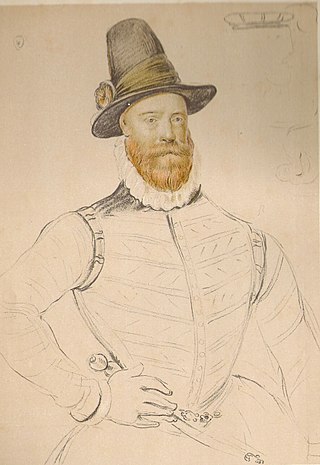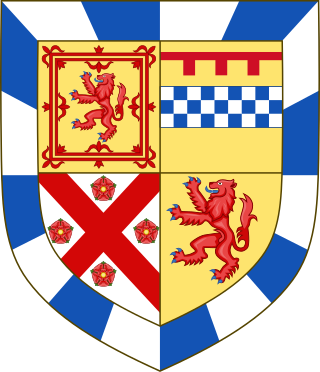Related Research Articles

James V was King of Scotland from 9 September 1513 until his death in 1542. He was crowned on 21 September 1513 at the age of seventeen months. James was the son of King James IV and Margaret Tudor, daughter of Henry VII of England. During his childhood Scotland was governed by regents, firstly by his mother until she remarried, and then by his second cousin, John Stewart, Duke of Albany. James's personal rule began in 1528 when he finally escaped the custody of his stepfather, Archibald Douglas, 6th Earl of Angus. His first action was to exile Angus and confiscate the lands of the Douglases.

James Douglas, 4th Earl of Morton was a Scottish nobleman. He played a leading role in the murders of Queen Mary's confidant, David Rizzio, and king Henry Darnley. He was one of the last of the four regents of Scotland during the minority of James VI and I. He was in some ways the most successful of the four, since he won the civil war that had been dragging on with the supporters of the exiled Mary, Queen of Scots. However, he came to an unfortunate end, executed by means of the Maiden, a predecessor of the guillotine.

The Battle of Solway Moss took place on Solway Moss near the River Esk on the English side of the Anglo-Scottish border in November 1542 between English and Scottish forces.

James Hamilton, 1st Duke of Châtellerault, 2nd Earl of Arran, was a Scottish nobleman and head of the House of Hamilton. A great-grandson of King James II of Scotland, he was heir presumptive to the Scottish throne. Arran was Regent of Scotland during the minority of Mary, Queen of Scots from 1543 to 1554, when he lost the regency to Mary of Guise. At first pro-English and Protestant, he converted to Catholicism in 1543 and supported a pro-French policy. He reluctantly agreed to Mary's marriage to Francis, eldest son of King Henry II of France, and was rewarded by Henry by being made Duke of Châtellerault in 1549. During the Scottish Reformation, Châtellerault joined the Protestant Lords of the Congregation to oppose the regency of Mary of Guise, and lost his French dukedom as a result.
William Douglas, 6th Earl of Morton was the son of Robert Douglas of Lochleven and Margaret Erskine, a former mistress of James V of Scotland.
George Gordon, 4th Earl of Huntly was a Scottish nobleman.

Sir James Hamilton of Finnart was a Scottish nobleman and architect, the illegitimate son of James Hamilton, 1st Earl of Arran, and Marion Boyd of Bonshaw. Although legitimated in 1512 while still a minor, he continued to be known as the "Bastard of Arran". As a key member of the Hamilton family, and second cousin of James V, King of Scotland, he became a prominent member of Scottish society.
Lady Margaret Erskine was a mistress of King James V of Scotland and mother of Regent Moray.
Malcolm Fleming, 3rd Lord Fleming, was Lord Chamberlain of Scotland to King James V, from 1524.
Anne Hamilton, Countess of Huntly, was a Scottish noblewoman and a member of the powerful Hamilton family which had a strong claim to the Scottish crown. Her father James Hamilton, Duke of Châtellerault, 2nd Earl of Arran was heir presumptive to the throne of Scotland after Mary, Queen of Scots prior to the birth of the latter's son Prince James in 1566. Anne was the wife of George Gordon, 5th Earl of Huntly, Lord Chancellor of Scotland and a chief conspirator during the reign of Queen Mary.
Mary Stewart, Countess of Arran was the elder daughter of King James II of Scotland and Mary of Guelders. King James III of Scotland was her eldest brother. She married twice: firstly, to Thomas Boyd, 1st Earl of Arran; secondly, to James Hamilton, 1st Lord Hamilton. It was through her children by her second husband that the Hamilton earls of Arran and the Stewart earls of Lennox derived their claim to the Kingdom of Scotland.

Agnes Leslie, Countess of Morton was a Scottish noblewoman, being the daughter of George Leslie, 4th Earl of Rothes as well as a great-granddaughter of King James II. She was the wife of William Douglas, 6th Earl of Morton, who as Laird of Lochleven Castle was the custodian of Mary, Queen of Scots during her captivity from June 1567 until her escape on 2 May 1568. Agnes was Queen Mary's chief female companion throughout her imprisonment; thus it was while Lady Agnes was recovering from childbirth that the queen successfully escaped from Lochleven.

George Hay, 7th Earl of ErrollPC was a Scottish nobleman and politician.
Sir Thomas Erskine of Haltoun and Brechin was the royal secretary to James V of Scotland from 1524.
Hugh Somerville, 5th Lord Somerville was a lord of the Parliament of Scotland. He is sometimes reckoned to be the 4th Lord Somerville. He succeeded his brother, John Somerville, 4th Lord Somerville. Hugh and John were sons of William Somerville, Master of Somerville, and Marjory Montgomerie.

George Douglas of Pittendreich was a member of the powerful Red Douglas family who struggled for control of the young James V of Scotland in 1528. His second son became James Douglas, 4th Earl of Morton and Regent of Scotland. Initially, George Douglas promoted the marriage of Mary, Queen of Scots and Prince Edward of England. After war was declared between England and Scotland he worked for peace and to increase the power of Mary of Guise, the widow of James V.

Andrew Stewart, 2nd Lord Avondale or Andrew Stuart, 1st Lord Ochiltree, was a Scottish peer.
Sir Robert Douglas of Lochleven was a Scottish courtier and landowner.
John Forbes, 6th Lord Forbes was a Scottish landowner.

Margaret Douglas, Countess of Arran and Duchess of Châtellerault was a Scottish aristocrat.
References
- ↑ G. R. Hewitt, 'Douglas, James, fourth earl of Morton (c.1516–1581)', Oxford Dictionary of National Biography, Oxford University Press, 2004.
- ↑ Calendar State Papers Scotland, vol. 1 (Edinburgh, 1898), 615.
- ↑ Registrum Honoris de Morton, vol. 2 (Bannatyne Club, 1853), pp. 263–265, 272–273, 288–293
- ↑ Cameron, Jamie, James V (Tuckwell, 1998), pp. 274–277.
- This article incorporates text from a publication now in the public domain : Chisholm, Hugh, ed. (1911). "Morton, James Douglas, 4th Earl of". Encyclopædia Britannica . Vol. 18 (11th ed.). Cambridge University Press. pp. 880–881.